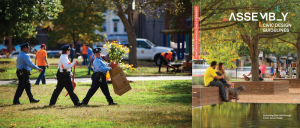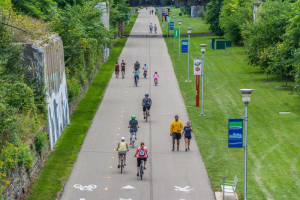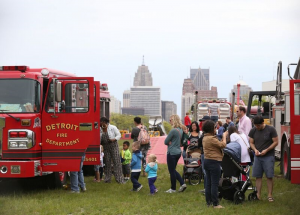By Bryan Ross, Associate at the Center for Active Design
Whether we are walking through a public plaza on the way to work, using the local library, picnicking in the park, or attending a meeting at town hall, we routinely interface with public spaces in our everyday lives. The Center for Active Design (CfAD) explores how public spaces can be designed to support community health.

CfAD recently released the Assembly: Civic Design Guidelines, a groundbreaking playbook, demonstrating how the design and maintenance of public spaces plays a key role in the promotion of civic life and community engagement. This publication focuses on how design can positively influence four key civic life outcomes: civic trust and appreciation, participation in public life, stewardship of the public realm, and informed local voting.
Research studies show that active participation in community organizations and activities is associated with lower mortality rates and better physical and mental health. Studies also demonstrate that people are more likely to use public space if they are involved in its development. The redevelopment of the Detroit Riverfront in Detroit, Michigan, is a perfect example of how the same strategies that promote civic life can also encourage increased physical activity among local community members.
 During the 20th century, the land fronting the Detroit River was dominated by industry. As those industries declined, the land languished in decay, marred by crime and pollution. Today that same waterfront is home to world-class parks, which have been transformed by a remarkable community vision, the Detroit RiverFront Conservancy, the guidance of an innovative group of civic and community leaders determined to provide safe, green, and accessible recreation space for all.
During the 20th century, the land fronting the Detroit River was dominated by industry. As those industries declined, the land languished in decay, marred by crime and pollution. Today that same waterfront is home to world-class parks, which have been transformed by a remarkable community vision, the Detroit RiverFront Conservancy, the guidance of an innovative group of civic and community leaders determined to provide safe, green, and accessible recreation space for all.
Redevelopment of the Dequindre Cut, a decommissioned train track, allowed pedestrians and cyclists to access the riverfront through a slice of pleasant urban greenery dotted with public art and congregation spaces. Studies have shown that efforts like the redevelopment of the Detroit Riverfront, which increase residents’ overall access to nature, are associated with increased physical activity and a significant reduction in self-reported poor mental health.
More than three miles of linear waterfront parks now teem with activity, attracting three million visitors each year. An emphasis on everyday comfort-providing amenities, like water fountains, cafes, and bathrooms, allows people to linger longer and bask in a space where others are doing the same.
“You see visitors from out of town and Detroiters who live in the neighborhoods; you see folks who are new to the city and folks who have been here for 85 years. It’s a special place where everyone feels pride in this community, where everyone can get along and be themselves.” – Mark Wallace, President & CEO, Detroit RiverFront Conservancy

Even in the harshest of winters, Detroiters flock to their beloved riverfront. The conservancy clears snow and offers winter-themed activities to support year-round enjoyment of the park. Facilitating everyday activity in this way keeps this public space alive and active, while marquee events with regional appeal punctuate the seasons with massive crowds. At the annual River Days Festival, admission prices are kept intentionally low, or even free, to ensure cost is not a barrier to participation.
Projects like the Detroit Riverfront are popping up across the country in towns and cities of all sizes—such as Chicago and Bradenton, among many others—revitalizing overlooked infrastructure, transforming individual behaviors, and creating positive and welcoming community dynamics.
This is just the beginning of a movement happening in communities across the United States, where the public spaces we interact with everyday can be designed and leveraged in support of community trust, participation, and stewardship – aspects of social cohesion that can strengthen neighborhood relationships and overcome past divisions.
Spread the Word! Share this post with your network using this sample tweet:
Public spaces are designed to support community health. @active_design takes a deep dive in this @HHSPrevention blog about how the @DetroitRvrfrnt is designed to promote civic life for local community members! https://bit.ly/2Mr1Qdw #designxciviclife